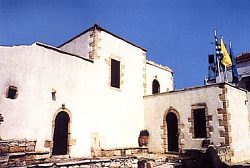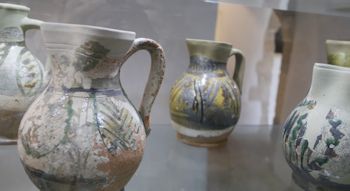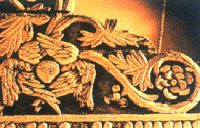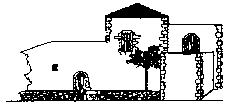THE HISTORICAL BUILDING
The building of the historical museum of
Gavalochori constitutes of a characteristic manifestation of the local architecture, which is developed in two levels.

The grounds floor with a "balcony", internal courtyard, the house with the arches and auxiliary rooms and a mezzanine living space. A portion of the building was constructed during the Venetian domination, whereas the mezzanine floor was added during the Turkish occupation. It used to be inhabited until the end of the last century. The heirs of its last inhabitants, namely the married couple George and Maria Stilianakis, offered it to the community of Gavalochori.
The exhibition of the objects takes place according to the contemporary museum conception, with explanatory texts, photographs, plans, models, and is enriched with new exhibits every year.
THE ARCHED HOUSE
Throughout Crete the arched house is a prevalent and beloved type of house.

The separation of the ground plan's rectangle with the arch creates four side rooms that are operationally independent, without splitting the unity of the space. These rooms are used as bedrooms, kitchen and as auxiliary rooms, such as for a winepress, a workroom, a store, etc. The kitchen space includes the oven and the fireplace. The fireplace is under the "updraft", the chimney through which the smoke escapes. The furniture of the house is plain, as is the house itself. It consists of: a loom, chairs, a mirror, a large sofa, the chest for the bride's trousseau, the lamp-holder oil lamp lighting the house, a hand mill for the grinding of the wheat, the earthenware oil and wine jars, the water pitchers and jars. The double functioning built wine press - on the one hand for the pressing of the grapes, and as a bed during the remaining year, on the other hand it completes the functionality of the arched house.
SILK
The use of local silk thread has been limited to home handicraft for the weaving of men's and women's clothes, home fabrics and decorative framing of family pictures.
POTTERY
Crete has a tradition of many centuries in the art of pottery. There are many and various pot forms reminding of striking Minoan models. The dimensions start with the small oil lamps and the incensories, the jugs and the jars, the plates and the earthenware basins, up to the large oil and wine earthenware jars.

THE "KOPANELI"
The appearance of the "kopaneli" in Crete dates from the Byzantine times. The "kopaneli" is the name of the technical interweaving of many threads on a vertical layout that are rolled around 14 narrow and long wood sticks that are called "kopanelia".
The women's occupation with the "kopaneli" aims mainly at the decoration of the home and of women's clothing and secondly helps at reinforcing the incomes of the household.
STONE CUTTING AND SCULPTURING
The mining and work processing of the stone constitutes a local traditional process. The artisans from Gavalochori extract and treat the stone with skill and art, and their works: lintels, doorsteps, door and
window pilasters, frames, stairs, fireplaces, chimneys, head columns, etc are maintained today as perfect examples of the stone sculpturing art.
WOODCARVING - ICONOGRAPHY
Crete, incorporated in the sphere of direct influence of Constantinople, carries on this activity in the field of religious art after its invasion by the Turks. The wood carved iconostases of Apokoronas presents the tripartite structure of the post-Byzantine iconostasis and is of an exceptional quality.

The impact of the West, the Renaissance and the Baroque mainly, is evident in the thematology as in the technique. The technique of horizontal sculpturing of the stone sculptured representations is repeated with the characteristic flowerpots, the rosettes and the carnations, the radial geometrical forms and the whirling vine. The wood carved iconostases of Apokoronas that are sculptured in cypress date from 1845 until the eve of World War II.
WEAPONS - COINS - HISTORICAL REPRESENTATION
The historical portion of museum exhibits weapons and swords from the Cretans' endless fights for freedom, a small part of the drawn paintings and historical lithographies, where there are graphic representations of the most important events of Greek and Cretan History. Roman, Byzantine, Venetian, Turkish coins, coins of the Cretan civilization and coins of Syracuse (405-345 BC). There are also medals of the people of Gavalochori that were won on the battlefields.
Historical and Folklore Museum of Gavalohori

Address: Gavalochori Apokoronou (Prefecture of Hania), Crete
Visiting hours for the public:
From Monday to Friday: 9 am - 8 pm
Suturday : 9 am - 7 pm
Sunday: 10 am - 1:30 pm and 5 pm - 8 pm
Winter:
From the 1st of November until the 31 of March 2010:
8:30-15:00
Telephone : +30 28250 23222